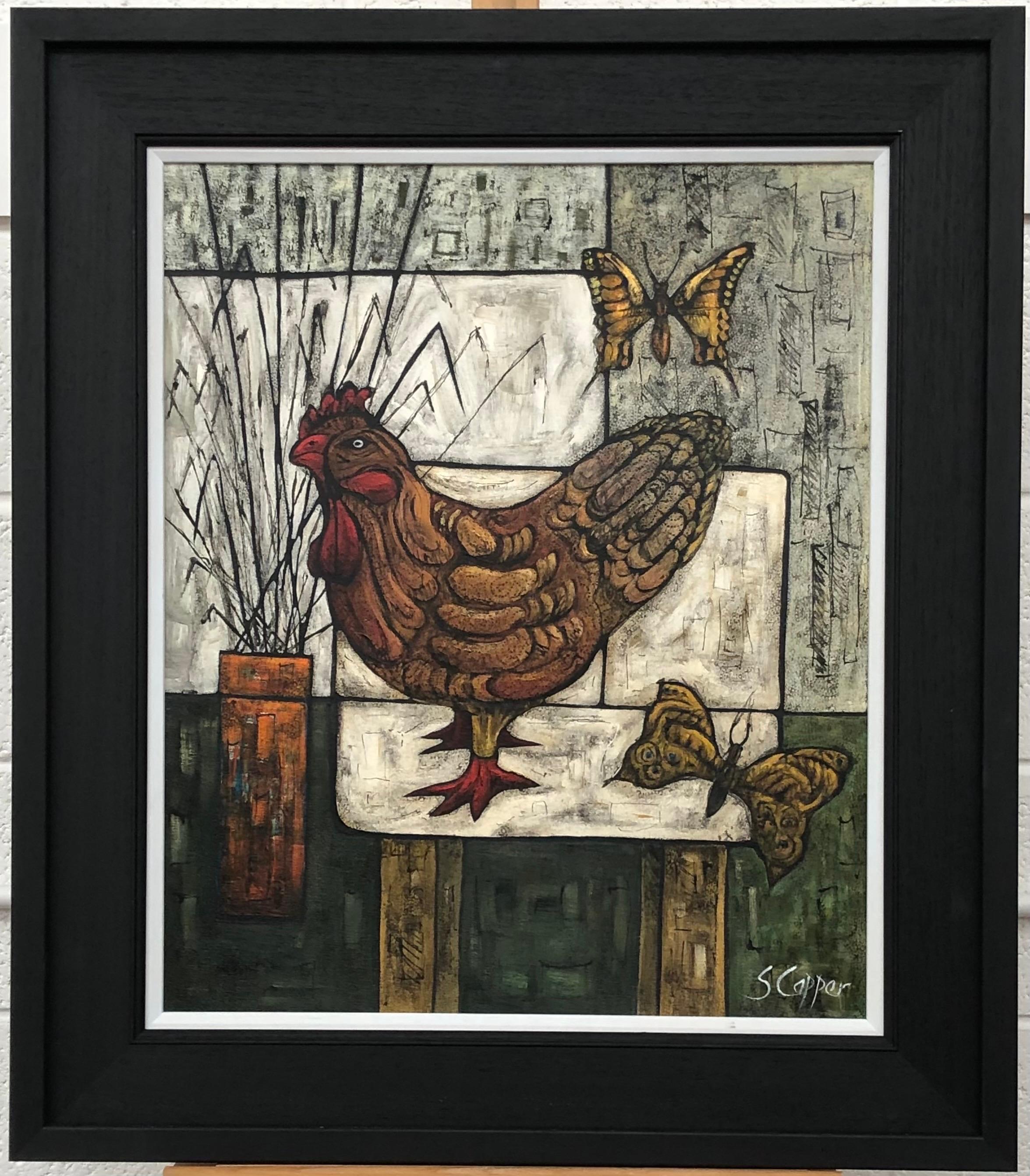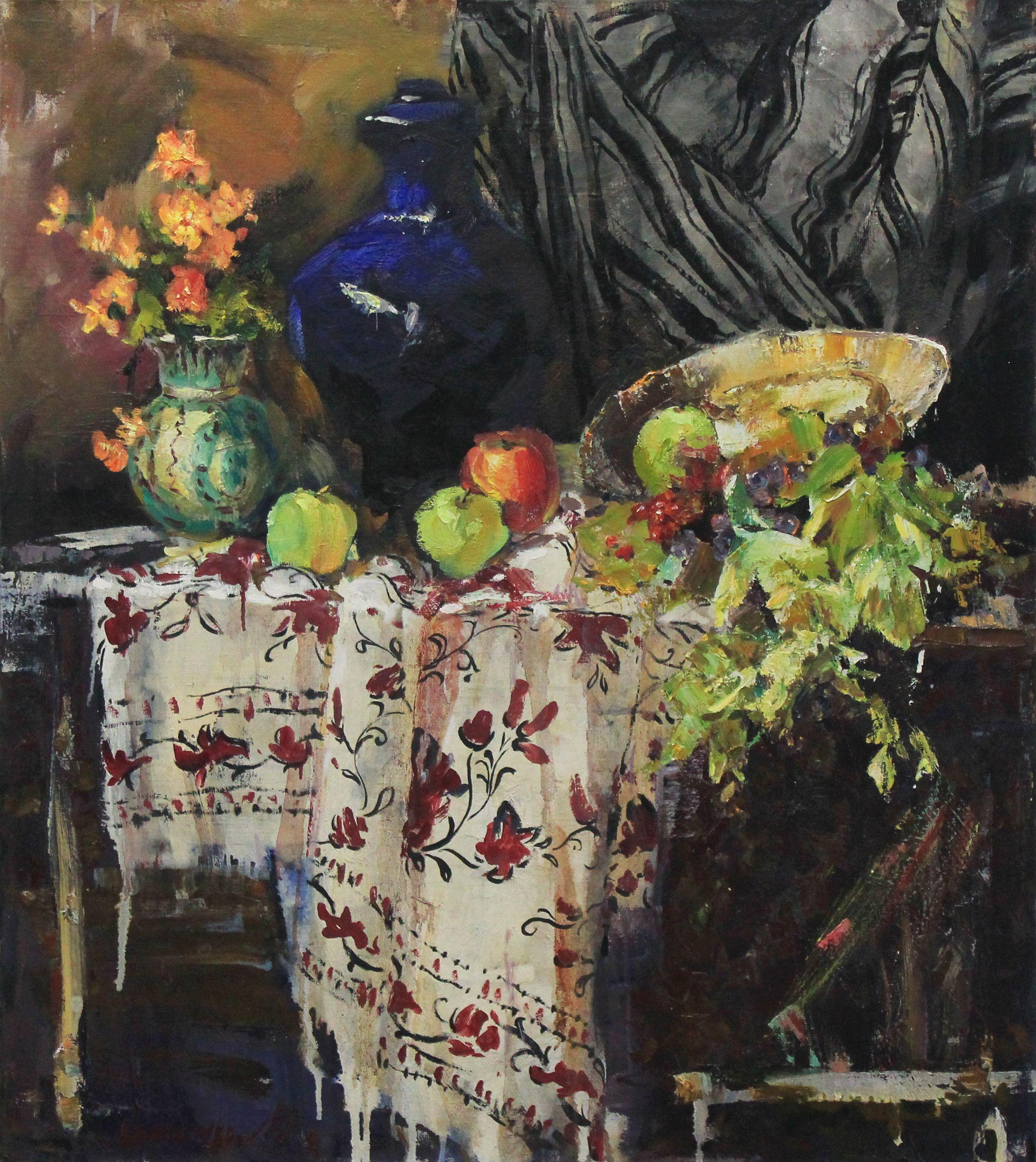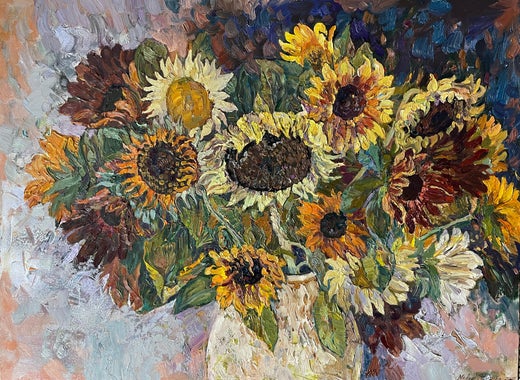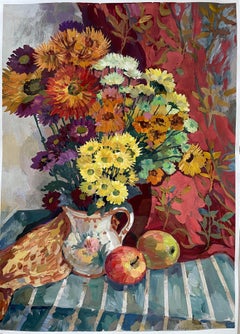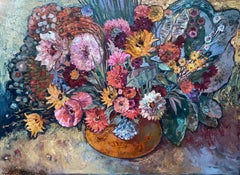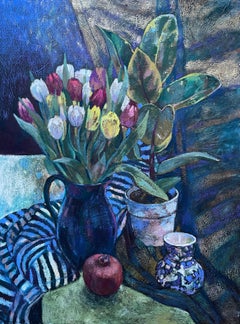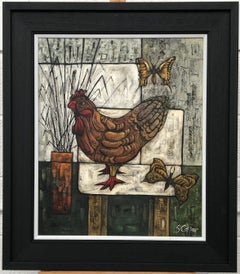Items Similar to Still life with chicken
Want more images or videos?
Request additional images or videos from the seller
1 of 13
Nadezda StupinaStill life with chicken2023
2023
$911.05
£676.78
€760
CA$1,265.10
A$1,380.52
CHF 724.10
MX$16,766.82
NOK 9,044.45
SEK 8,547.46
DKK 5,785.80
About the Item
In this painting, I infused the vitality of nature and domestic tranquility through bold strokes and vibrant gouache colors. The rooster stands proudly, symbolizing wakefulness and the dawn of new beginnings, amidst the stillness of fruit and flora, capturing the essence of life's simple, yet profound cycles. The artwork embodies a rustic elegance that is both comforting and inspiring, perfect to enliven any space with warmth and a touch of the pastoral.
- Creator:Nadezda Stupina (1967, Russian)
- Creation Year:2023
- Dimensions:Height: 39.38 in (100 cm)Width: 27.56 in (70 cm)Depth: 0.04 in (1 mm)
- More Editions & Sizes:100x70. Edition of 1Price: $911
- Medium:Gouache,Bamboo Paper
- Movement & Style:
- Period:
- Framing:Framing Options Available
- Condition:
- Gallery Location:Oslo, NO
- Reference Number:Seller: Certificate of authenticity1stDibs: LU2717214733312
Born in Oryol in 1967 in Russia. Being an artist has been a dream since childhood. At the age of 10, went to an art school, and then continued my education at an art college, and then at the Faculty of Applied Arts of the Textile Academy. Good academic training and at the same time a decorative and applied bias in higher education. As an artist, it laid a very good foundation.Despite the fact that I worked as an interior designer for many years, the dream of devoting myself only to painting did not leave. And this has happened since 2005. It was a step of faith towards a dream. And the more I worked and delved into painting, the more she realized that this is my path. "Painting is my passion, my method of understanding the world, my self-expression, my air that I breathe."
For me , it is important that the works resonate with the audience,and she is happy that hundreds of her works have been bought by collectors around the world and are successfully sold on the world's largest auctions, such as Christie's . My art is primarily addressed to feelings and emotions. When I start a new series or a new painting, I myself expect magic. I am always interested in where this path that I have embarked on will lead. For me , the atmosphere, immersion and aftertaste are much more important than the narrative plot. The artist always tries to dive deeper into the image, for me it is important to convey emotions first of all, which will lead the viewer to think. I consider experimentation and the search for new artistic forms to be a very important aspect of creativity.The artist experiments a lot with different media and various techniques, which I often come up with myself. I am a participant in dozens of different exhibitions and international projects. My paintings have repeatedly won international art competitions.
About the Seller
5.0
Platinum Seller
Premium sellers with a 4.7+ rating and 24-hour response times
Established in 2021
1stDibs seller since 2024
56 sales on 1stDibs
- ShippingRetrieving quote...Shipping from: Oslo, Norway
- Return Policy
Authenticity Guarantee
In the unlikely event there’s an issue with an item’s authenticity, contact us within 1 year for a full refund. DetailsMoney-Back Guarantee
If your item is not as described, is damaged in transit, or does not arrive, contact us within 7 days for a full refund. Details24-Hour Cancellation
You have a 24-hour grace period in which to reconsider your purchase, with no questions asked.Vetted Professional Sellers
Our world-class sellers must adhere to strict standards for service and quality, maintaining the integrity of our listings.Price-Match Guarantee
If you find that a seller listed the same item for a lower price elsewhere, we’ll match it.Trusted Global Delivery
Our best-in-class carrier network provides specialized shipping options worldwide, including custom delivery.More From This Seller
View AllOriental Still Life. Vertical, oil, bright, painting, fruits
Located in Oslo, NO
The oriental still life was painted in the artist's garden in summer 2020. Why was this topic chosen? Because she was born in eastern Kyrgyzstan and visited Uzbekistan and Kyrgyzstan...
Category
2010s Post-Impressionist Still-life Paintings
Materials
Oil
”Autumn bouquet” Original still life painting. Home decor
Located in Oslo, NO
This captivating still life painting vividly captures the essence of a lively bouquet. A diverse array of colorful flowers, dominantly in yellows, oranges, purples, and whites, burst...
Category
2010s Fauvist Still-life Paintings
Materials
Paper, Gouache
Bizarre bouquet
Located in Oslo, NO
This vibrant artwork showcases an abundant bouquet of flowers, expertly arranged in a rustic, earth-toned vase. The composition bursts with a rich pal...
Category
2010s Fauvist Still-life Paintings
Materials
Canvas, Oil
«Still Life with striped draperies» Original . Impressionistic painting .
Located in Oslo, NO
This striking still life artwork vividly captures an arrangement of everyday objects with a bold use of color and texture. A luscious bouquet of tulips in varied shades of red, white...
Category
2010s Impressionist Still-life Paintings
Materials
Canvas, Oil Pastel
Still life with pomegranate
Located in Oslo, NO
This captivating artwork features a vivid still life composition dominated by a potted plant with lush, broad leaves, prominently positioned in the foreground. The plant's leaves exh...
Category
2010s Post-Impressionist Still-life Paintings
Materials
Wood, Gouache
My sweet chick, still life, acrylic, vertical, Coffee
Located in Oslo, NO
"Did you know that it is illegal to eat an omelette without a parrot?" said Anait about this painting. "Our parrot Kuzya will soon be 10 years old. He is my true co-author, he takes ...
Category
2010s Contemporary Figurative Paintings
Materials
Acrylic
You May Also Like
Still Life Painting with Chicken by Fauvist British Artist
By Steve Capper
Located in Preston, GB
Still Life Painting with Chicken by Fauvist British Artist, Steve Capper
Art measures 20 x 24 inches
Frame measures 25.5 x 30 inches (approx.) ...
Category
2010s Expressionist Still-life Paintings
Materials
Canvas, Paint, Cotton Canvas, Mixed Media, Acrylic, Board
$2,471 Sale Price
20% Off
Still life with chicken. Oil on canvas, 50 x 61 cm
Located in Riga, LV
Still life with chicken and mushrooms. Oil on canvas, 50 x 61 cm
hunting theme in painting
Marc Sterling (1895-1976)
Marc Sterling was born in Pryluky, a small town in Ukraine, wher...
Category
Mid-20th Century Realist Still-life Paintings
Materials
Canvas, Oil
$7,672 Sale Price
20% Off
Still Life with Rooster and Tulips, Original Painting, Ready to Hang
Located in Granada Hills, CA
Artist: Boris Serdyuk
Work: Original painting, handmade artwork, one of a kind
Medium: Pastel on Paper
Style: Impressionism
Year: 2020
Title: Still Life with Rooster and Tulips
Size: 27.5" x 19.5" x 0.8'' inch, (70x50x3 cm)
Unframed, Stretched on Wooden Bar, Gallery Wrapped, Ready to Hang.
About the artists:
Serdyuk Boris Petrovich...
Category
2010s Impressionist Still-life Paintings
Materials
Paper, Pastel
Still life Oil/cardboard, 69x99 cm.
By Aija Zarina
Located in Riga, LV
Aija Zariņa is a prominent personality in Latvian art, actively advocating for idealism and personal freedom, against conformism. Her main theme is human existence, its fundamental c...
Category
1980s Fauvist Still-life Paintings
Materials
Oil, Cardboard
"UKRAINIAN STILL LIFE", Painting, Oil on Canvas
Located in Yardley, PA
One of a kind original Oil painting by Ukrainian artist Alisa Onipchenko-Cherniakovska - Canvas painting stretched and ready to hang (NOT FRAMED. The sides are painted with acrylic. ...
Category
2010s Impressionist Paintings
Materials
Oil
Still life with meat
Located in Zofingen, AG
Original oil painting on canvas, still life painting made under natural light. This artwork is painted using high-quality fine linen canvas, already stretched and ready to hang with ...
Category
2010s Realist Still-life Paintings
Materials
Oil
More Ways To Browse
Soda Crate
Still Life Banana Art
Vanitas Still Life Paintings
Wine Bottle Still Life
Claude Debussy
Fauvist Flowers
Palette Knife Flowers
Roys People
Still Life Floral Realism
Cupcake Painting
Impressionist Purple Flowers Painting
Le Buisson
Objective Object
Oil Painting Zinnias
Tulips In Vase Painting
What The Butler Saw
Fig Still Life
Lorjou Bernard
